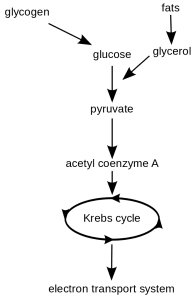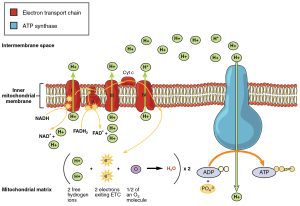3.6 Cellular Respiration
Cellular Respiration is a fundamental biological process with the chemical equation: C6H12O6 + O2 → H2O + CO2. It is an essential mechanism that all organisms, including those capable of photosynthesis, use to generate energy. Through this process, carbohydrates (typically represented by glucose) are broken down to release energy, which is stored in the form of ATP (adenosine triphosphate). Think of cellular respiration as almost the reverse of photosynthesis. If you’ve got a grasp on photosynthesis, respiration should make a lot more sense!

The Three Major Steps of Cellular Respiration
Cellular Respiration can be broken down into three major steps: glycolysis, the Krebs cycle, and the electron transport chain. Glycolysis takes place in the cytoplasm of the cell, while the Krebs cycle and the electron transport chain occur inside the mitochondria.
1. Glycolysis
Glycolysis is one of the most ancient and evolutionarily conserved processes in cellular respiration. It occurs in nearly every living organism in a similar fashion. Glycolysis involves breaking down a glucose molecule (which contains six carbons) into two molecules of pyruvate (each containing three carbons). In this process, a small amount of energy is captured, resulting in the production of 2 ATP molecules and several NADH molecules that act as electron carriers.
Before pyruvate can enter the Krebs cycle, it undergoes pyruvate oxidation to form acetyl CoA, a two-carbon molecule. During this step, each pyruvate molecule releases carbon dioxide.
2. Krebs Cycle
The Krebs Cycle occurs in the mitochondria. Similar to the Calvin Cycle in photosynthesis, several enzyme-catalyzed reactions take place. The cycle ultimately results in the breakdown of acetyl CoA, generating electron carriers like NADH and FADH2 and a small amount of energy (about 2 ATP). These electron carriers are vital as they move on to power the electron transport chain.

3. Electron Transport Chain
The Electron Transport Chain (ETC) is the final stage, where the bulk of ATP production occurs. Hydrogen ions, which are transported by NADH and FADH2, are pumped across the plasma membrane to create a high concentration gradient. The electrons travel through electronegative proteins in the ETC, eventually binding with oxygen, the final electron acceptor. This process creates water as a byproduct.
The movement of hydrogen ions back across the membrane, through ATP synthase, generates ATP in a process known as chemiosmosis. This step results in the production of 30-40 ATP molecules, significantly more than glycolysis or the Krebs cycle alone.
Another important function of the electron transport chain is the recycling of electron carriers. Once they drop off their electrons, these carriers can be reused in glycolysis or the Krebs cycle, maintaining the cycle’s efficiency.

Fermentation: An Alternative Pathway
When oxygen is not available, some organisms can still produce energy through a process called anaerobic respiration, which is commonly known as fermentation. In this case, instead of utilizing the electron transport chain, cells recycle their electron carriers through fermentation, creating byproducts such as lactic acid (in animals) or ethanol (in yeast and bacteria). During anaerobic respiration, only glycolysis takes place, and much less ATP is produced compared to aerobic respiration.
In humans, anaerobic respiration occurs in muscle cells during strenuous activities when oxygen is depleted. The resulting lactic acid buildup is what often causes muscle soreness after intense exercise.

Summary
The three stages of cellular respiration—glycolysis, the Krebs cycle, and the electron transport chain—work in tandem to produce ATP, the primary source of energy for cells. Aerobic respiration is highly efficient, yielding significantly more ATP compared to anaerobic pathways like fermentation. While anaerobic processes can temporarily provide energy, they are much less efficient compared to cellular respiration with oxygen.
Check out the AP Bio Unit 3 Replays or watch the 2021 Unit 3 Cram for a deeper dive into cellular respiration and practice questions.
Key Review Questions:
What is the main outcome of glycolysis in cellular respiration?
Breaking down glucose into two 3-carbon molecules of pyruvate.
What role does oxygen play in the electron transport chain?
Oxygen acts as the final electron acceptor, forming water as a byproduct.
Key Terms to Remember
Acetyl CoA: Molecule that delivers the acetyl group to the Krebs cycle.
Anaerobic Respiration: Energy production without oxygen, often involving fermentation.
ATP Synthase: Enzyme that produces ATP using a proton gradient.
Chemiosmosis: The process of ATP production driven by a hydrogen ion gradient.
Electron Transport Chain: The final stage in cellular respiration that produces the majority of ATP.







